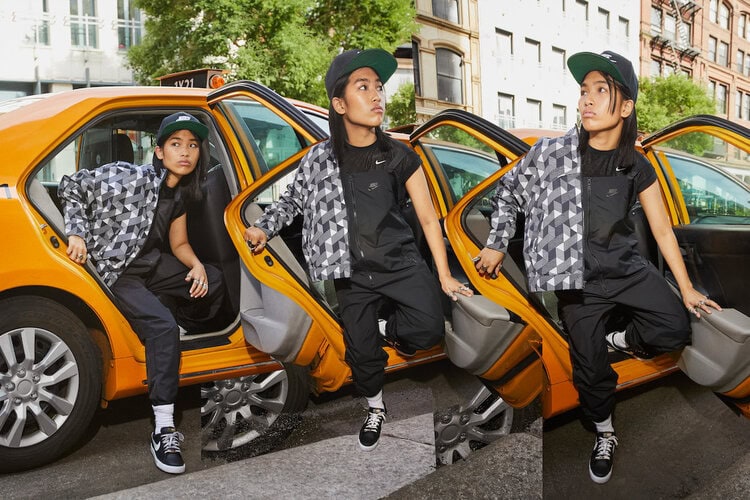The Serena Williams Design Crew gives a voice to aspiring designers from underrepresented backgrounds.
Serena Williams had a simple question three years ago during one of her standard check-in meetings with Nike execs and design leadership teams:
“Has anyone done this?”
“Quite honestly, no,” Jonathan Johnsongriffin, Nike VP and Global Creative Director replied.
From that point on, the Serena Williams Design Crew – a platform that helps designers from underrepresented backgrounds gain access to the athletic apparel industry – was officially underway, with the concept, specifics, and hopeful impact all hashed out by the end of the day.
“You could feel the spirit, the energy coming from Serena in that conversation,” Johnsongriffin said.
Officially launched behind the scenes in early 2020, 10 aspiring designers from New York were tapped to take part in the Design Crew’s inaugural class at Nike headquarters in Beaverton, Oregon. Together, they’d become immersed in the professional design world — and eventually, call upon all their skills to land a potential full-time design job with the iconic brand.
But all told, the new platform and six-month design apprenticeship are rooted in more than just creating and launching yet another collection of Serena-branded products as part of her long-term Nike endorsement deal.
Perhaps the 23-time Grand Slam singles champ herself puts it best:
“I’m changing the world of design.”
Diversity and representation have long been issues at the corporate level of athletics. Brands have done their best to respond, pledging tens of millions to community organizations amid a nationwide outcry for social justice and equality.
But the dynamics within the corporate walls still have some ways to go.
During the opening scene of the SWDC’s official launch video, headlines and stats fly across the screen.
“73% white...
…Black designers?
… Removing barriers.”
While brands have long partnered with Black athletes, tastemakers, and musicians, the demographics of the company workforces benefitting from their influence ultimately haven’t grown as diverse long-term.
Seven of the 10 students that took part in the inaugural SWDC have since been hired as full-time designers at Nike.
“It’s a plan to make the composition of our company more closely reflect that of our athletes and the communities we serve,” said John Hoke, Nike’s Chief Design Officer.

Along the way, the designers took part in a series of skill workshops at the PENSOLE Footwear Design Academy in downtown Portland, founded by Dr. D’Wayne Edwards. A former Jordan Design Director, Edwards took matters into his own hands when he noticed the next generation wasn’t well equipped in design education, nor was it diverse enough.
He left his dream job at Nike Inc. in 2010 to launch PENSOLE a decade ago.
In the years since then, the academy has prioritized hosting diverse classes of graduates and placed more than 500 former students into internships and full-time positions at companies worldwide.
“Diversity equals innovation,” Edwards said. “We only become what we see.”
As part of its partnership with PENSOLE, the Serena Williams Design Crew students received access to design tools like lasting machines, 3-D prototyping technology, and the academy’s endless material and color design lab, helmed by former Jordan Brand materials designer Suzette Henry.
Along with Edwards, one of the highest-ranking Black Nike design executives during his career with the company, the SWDC program also tapped Wilson Smith III, Nike’s first Black designer and one of the most innovative minds behind several industry-defining basketball and tennis products throughout the 1990s. Smith had also helped to design for Serena in his prior role as Design Director of Nike Court.
“When you’re first, you’re there to hopefully make a way for the next group,” he said.
Throughout the six-month apprenticeship, the Crew crafted its designs much like the brand’s normal product creation process, alongside a team of product marketers and developers to create a 20-item footwear, apparel, and accessories collection.
Items featured traditional West African prints atop inclusive silhouettes, along with bolder pattern color blocks and color palettes designed to suit a variety of skin tones. One notable piece, a basketball jersey featuring No. 00, is a nod to the middle and last names of Serena’s daughter, Alexis Olympia Ohanian.
Once the coronavirus pandemic hit, the students took things virtual, presenting their designs and concepts to Serena via Zoom for rounds of feedback, and eventually, her signature sign-off.
“The future of sport is creative, inclusive, and unlimited in possibility — everyone is invited to play,” Williams said. “My partnership with Nike on the Serena Williams Design Crew builds on that same spirit of inclusivity and extends into design — at Nike, across the industry, and around the world.”
The first SWDC collection will launch on Nike platforms on Sept. 1 in tandem with Serena’s quest for a record-tying 24th Grand Slam singles title at the US Open in New York, which begins Aug. 30.
But even now, a team of 11 students from Chicago are already working away on the next Serena Williams Design Crew collection, placing a continued emphasis on providing access to a diverse group of students and potential full-time opportunities after they graduate from the program.
“We’re talking about what building the bench looks like here at the company, bringing the next generation forward in the design space,” said Tania Flynn, Nike VP of Women’s Apparel Product Design. “And that challenges us to think about diversity in all forms. It’s not just across race, gender, or sexual orientation. It’s important to have diversity of experience, tenure, and age, too.”
For Williams, who first noticed the lack of diversity across the industry years ago, she’s hoping the added platform for designers can also inspire the next generation to consider a future in design in the athletic industry.
“The talent was out there,” Williams said. “They just needed to get through the door.”








